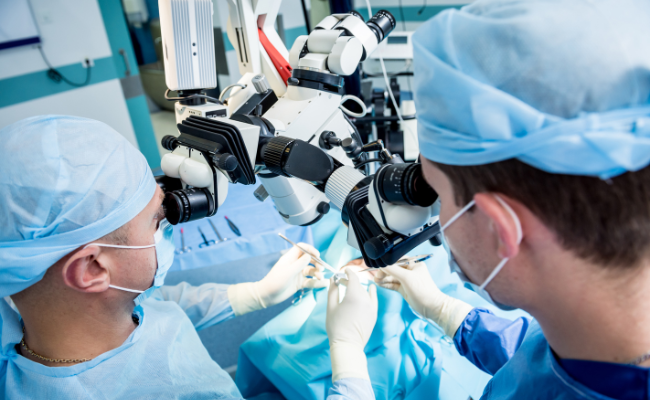How to Treat Craniotomy?
- December 12, 2023
- No Comments

What is Craniotomy?
Craniotomy, a significant neurosurgical procedure, involves the meticulous opening of the skull to provide direct access to the brain. Derived from the words "cranium" and "otomy," this intricate surgery is indispensable in treating various complex brain conditions that cannot be adequately addressed through non-invasive methods. A cornerstone of neurosurgery, craniotomy entails the removal and temporary replacement of a portion of the skull, known as the bone flap, using specialized tools.
Why is Craniotomy Performed?
- Brain Tumors: Among its applications, craniotomy shines in the precise removal or biopsy of brain tumors. Surgeons navigate intricate brain structures to excise abnormal growths, emphasizing maximal tumor removal while preserving the integrity of adjacent healthy brain tissue.
- Aneurysm Repair: In instances of a cerebral aneurysm, craniotomy is instrumental in reinforcing a weakened blood vessel wall. This surgical intervention becomes a crucial means of averting the risk of rupture and potential life-threatening bleeding within the brain.
- Traumatic Brain Injury (TBI): Severe head injuries often necessitate the performance of a craniotomy. By expertly addressing swelling, removing damaged tissue, and alleviating pressure on the brain, this procedure becomes a vital component in preventing further neurological damage.
- Blood Clot Evacuation: Hematomas or blood clots within the brain find resolution through craniotomy. This procedure becomes a critical intervention, significantly reducing the risk of additional neurological damage.
- Epilepsy Treatment: Craniotomy is occasionally employed to surgically remove specific brain tissue responsible for seizures, offering relief for individuals grappling with epilepsy.
The Intricacies of Craniotomy Procedure:
The craniotomy procedure unfolds in a series of meticulously orchestrated steps:
- Patient Preparation: Prior to the surgery, the patient is carefully positioned on the operating table, and general anesthesia is administered, inducing a state of unconsciousness crucial for the successful execution of the procedure.
- Incision: A strategically planned incision is meticulously made in the scalp, revealing the skull. The size and location of this incision are determined by the specific condition being treated.
- Bone Flap Removal: The use of specialized tools is integral to the precise removal of a bone flap from the skull. This bone flap is temporarily taken out, facilitating unimpeded access to the brain.
- Brain Exposure and Treatment: With the brain exposed, surgeons navigate the intricacies of the organ to perform the necessary treatments. This could encompass tumor removal, aneurysm repair, clot evacuation, or other targeted interventions.
- Closure: The final stages involve repositioning and securing the bone flap using plates, screws, or fixation devices. The scalp incision is meticulously closed with sutures or staples, ensuring a secure and optimal outcome.
- Postoperative Care: Following the completion of the surgery, patients are transferred to the intensive care unit (ICU) for closely monitored care. This phase includes pain management, infection prevention, and addressing any immediate postoperative concerns.
Treatment Solutions and Technological Advancements:
Craniotomy has evolved with advancements in surgical techniques and technology:
- Minimally Invasive Techniques: Innovations in surgical technology have given rise to minimally invasive craniotomy procedures. These techniques, characterized by smaller incisions and specialized instruments, minimize the impact on surrounding tissues.
- Navigational Systems: Advanced navigational systems, such as neuronavigation or stereotactic guidance, enhance precision during craniotomy. Real-time imaging and mapping assist surgeons in navigating complex brain structures with unparalleled accuracy.
- Intraoperative Imaging: Some craniotomy procedures integrate intraoperative imaging tools, allowing surgeons to assess progress and make real-time adjustments. This heightened accuracy ensures optimal outcomes.
- Cerebral Monitoring: Monitoring devices are deployed during surgery to assess brain function, guaranteeing that vital areas remain uncompromised during the intervention.
The Multifaceted Benefits of Craniotomy:
- Targeted Treatment: Craniotomy's precision allows for the targeted treatment of specific areas within the brain, ensuring the removal or treatment of abnormal structures while minimizing damage to healthy tissue.
- Life-Saving Interventions: In emergencies such as traumatic brain injuries or aneurysm ruptures, craniotomy stands as a life-saving procedure, swiftly addressing underlying issues and preventing further damage.
- Neurological Symptom Improvement: Conditions like brain tumors or epilepsy witness a significant improvement in neurological symptoms post-craniotomy, enhancing overall patient quality of life.
- Customized Approaches: Each craniotomy is meticulously tailored to the individual patient and their specific condition, embodying a customized and patient-centered approach to treatment.
- Advancements in Technology: The continual evolution of surgical techniques and technology contributes to ongoing enhancements in the safety and efficacy of craniotomy procedures, ultimately fostering improved patient outcomes.
Comments (0)